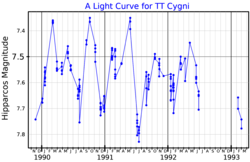| Observation data Epoch J2000.0 Equinox J2000.0 | |
|---|---|
| Constellation | Cygnus |
| Right ascension | 19h 40m 57.01599s[2] |
| Declination | +32° 37′ 05.7555″[2] |
| Apparent magnitude (V) | 7.26 - 8.0[3] |
| Characteristics | |
| Evolutionary stage | AGB |
| Spectral type | C5,4e(N3e)[3] |
| B−V color index | +2.917±0.073[4] |
| Variable type | SRb[5] |
| Astrometry | |
| Radial velocity (Rv) | −49.0±3.1[4] km/s |
| Proper motion (μ) | RA: −5.178[2] mas/yr Dec.: −1.832[2] mas/yr |
| Parallax (π) | 1.4908 ± 0.0368 mas[2] |
| Distance | 2,190 ± 50 ly (670 ± 20 pc) |
| Absolute magnitude (MV) | −1.297 (var.)[6] |
| Details | |
| Radius | 166[7] R☉ |
| Luminosity | 2,735[8] L☉ |
| Surface gravity (log g) | −0.4[8] cgs |
| Temperature | 3,200[8] K |
| Other designations | |
| Database references | |
| SIMBAD | data |
TT Cygni is a carbon star located 561 parsecs (1,830 ly) away in the northern constellation of Cygnus. It is classified as a semiregular variable of subtype SRb that ranges in brightness from magnitude 7.26 down to 8.0 with a period of 118 days.[3] This object is called a carbon star because it has a high ratio of carbon to oxygen in its surface layers. The carbon was produced by helium fusion, dredged up from inside the star by deep convection triggered by a flash from the helium shell.
A thin spherical shell around the star, about half a light year across, was emitted 7,000 years ago.[10] It was first detected from its carbon monoxide emission and has a mass around four thousandths M☉, of which about a tenth is dust. The dust is thought to be mostly amorphous carbon.[8]
References
[edit]- ^ "Hipparcos Tools Interactive Data Access". Hipparcos. ESA. Retrieved 8 December 2021.
- ^ a b c d e Brown, A. G. A.; et al. (Gaia collaboration) (August 2018). "Gaia Data Release 2: Summary of the contents and survey properties". Astronomy & Astrophysics. 616. A1. arXiv:1804.09365. Bibcode:2018A&A...616A...1G. doi:10.1051/0004-6361/201833051. Gaia DR2 record for this source at VizieR.
- ^ a b c "TT Cygni", International Variable Star Index, AAVSO, retrieved 2021-02-04.
- ^ a b Anderson, E.; Francis, Ch. (2012), "XHIP: An extended hipparcos compilation", Astronomy Letters, 38 (5): 331, arXiv:1108.4971, Bibcode:2012AstL...38..331A, doi:10.1134/S1063773712050015, S2CID 119257644.
- ^ Samus, N. N.; et al. (2017), "General Catalogue of Variable Stars", Astronomy Reports, 5.1, 61 (1): 80–88, Bibcode:2017ARep...61...80S, doi:10.1134/S1063772917010085, S2CID 125853869.
- ^ Gontcharov, G. A. (2011), "The red giant branch in the Tycho-2 catalogue", Astronomy Letters, 37 (10): 707–717, arXiv:1607.00557, Bibcode:2011AstL...37..707G, doi:10.1134/S1063773711090040, S2CID 119272127.
- ^ McDonald, I.; Zijlstra, A. A.; Watson, R. A. (2017), "Fundamental parameters and infrared excesses of Tycho–Gaia stars", Monthly Notices of the Royal Astronomical Society, 471 (1): 770–791, arXiv:1706.02208, Bibcode:2017MNRAS.471..770M, doi:10.1093/mnras/stx1433.
- ^ a b c d Groenewegen, M. A. T. (2012), "An extension of the DUSTY radiative transfer code and an application to OH 26.5 and TT Cygni", Astronomy and Astrophysics, 543: A36, Bibcode:2012A&A...543A..36G, doi:10.1051/0004-6361/201218965.
- ^ "TT Cyg". SIMBAD. Centre de données astronomiques de Strasbourg. Retrieved 2021-02-03.
{{cite web}}: CS1 maint: postscript (link) - ^ Olofsson, H.; et al. (January 2000), "A high-resolution study of episodic mass loss from the carbon star TT Cygni", Astronomy and Astrophysics, 353: 583–597, Bibcode:2000A&A...353..583O.

Well, that’s interesting to know that Psilotum nudum are known as whisk ferns. Psilotum nudum is the commoner species of the two. While the P. flaccidum is a rare species and is found in the tropical islands. Both the species are usually epiphytic in habit and grow upon tree ferns. These species may also be terrestrial and grow in humus or in the crevices of the rocks.
View the detailed Guide of Psilotum nudum: Detailed Study Of Psilotum Nudum (Whisk Fern), Classification, Anatomy, Reproduction